Firefly Species and Nocturnal Activity Patterns of Adults in Peri-Urban Forests of Dongguan
Abstract
1. Introduction
2. Materials and Methods
2.1. Study Area
2.2. Research Methods
2.2.1. Survey on Activity Patterns of Fireflies
2.2.2. Survey on Flight Characteristics of Fireflies
2.2.3. Survey on Species Identification of Fireflies
3. Results
3.1. Species Composition of Fireflies in Dalingshan Forest Park and Its Forest Science Trail
3.2. Temporal Characteristics of Nocturnal Activity of Adult Fireflies in the Forest Science Trail
3.2.1. Seasonal Distribution Characteristics of Firefly Activity
3.2.2. Overall Rhythm of Fireflies’ Nocturnal Activity
3.2.3. Nocturnal Activity Rhythms Among Firefly Species
3.3. Flight Height Characteristics of Fireflies in the Forest Science Trail
3.3.1. Overall Characteristics of Fireflies’ Flight Height
3.3.2. Flight Height Characteristics of Different Species of Fireflies
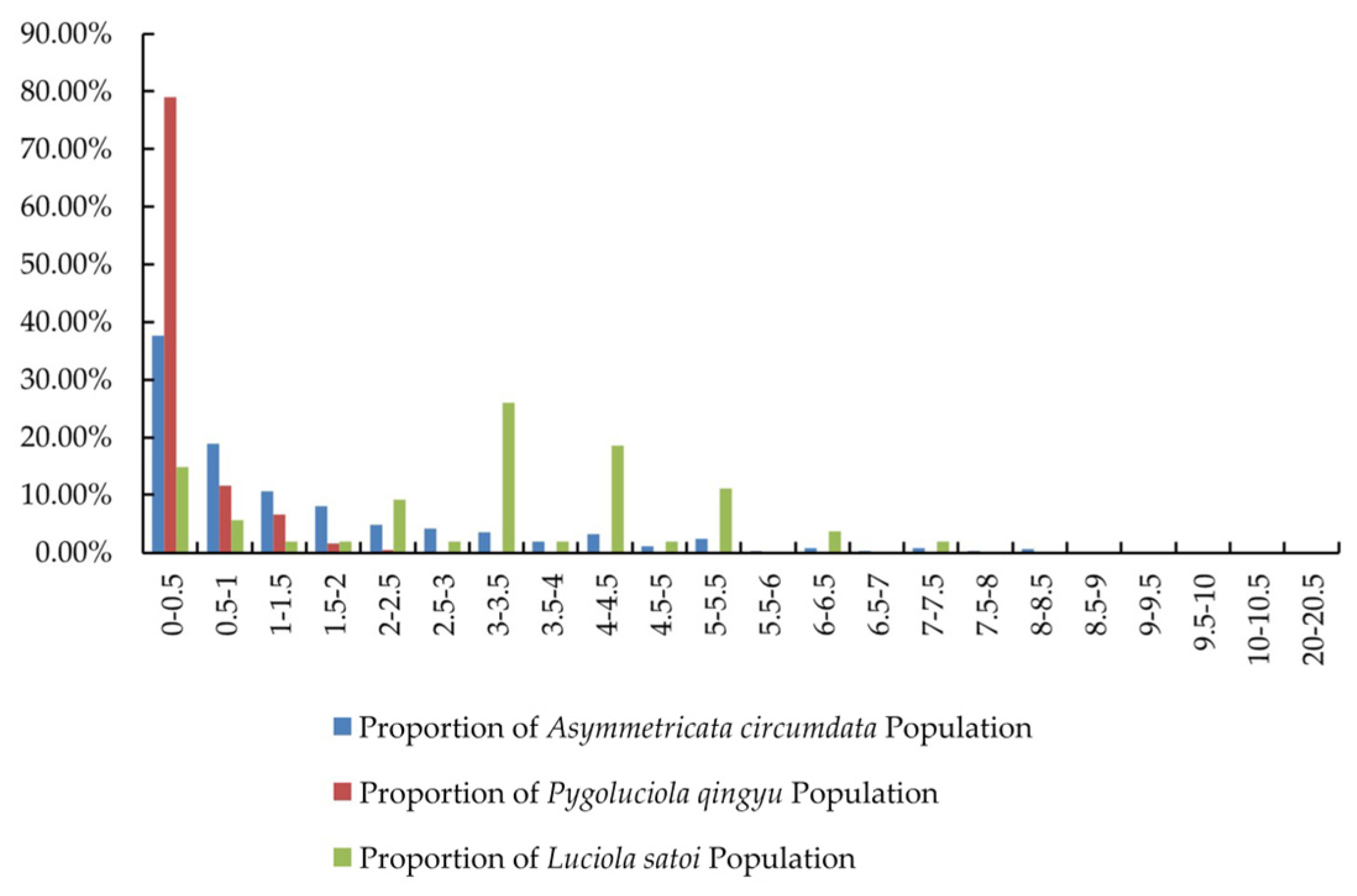
3.4. Flight Characteristics of Fireflies in the Forest Science Trail
3.4.1. Flight Types of Fireflies
3.4.2. Flight Trajectories of Fireflies
4. Discussion
4.1. Habitats of Dalingshan Forest Park and Its Forest Science Trail and the Maintenance of Firefly Diversity
4.2. Nocturnal Activity Period of Fireflies
4.3. Flight Height of Fireflies and Habitat Vegetation Management
4.4. Extending the Firefly Viewing Season: Preliminary Strategies and Ideas
5. Conclusions
Author Contributions
Funding
Data Availability Statement
Acknowledgments
Conflicts of Interest
References
- Chen, B.; Cao, B.R.; Yan, Z.T. Classification, biological characteristics, protection and utilization of fireflies. Univ. Sci. 2020, 14, 34–37. [Google Scholar]
- Dong, Z.W.; Yiu, V.; Liu, G.C.; He, J.W.; Zhao, R.P.; Peng, Y.Q.; Li, X.Y. Three new species of Lamprigera Motschulsky (Coleoptera, Lampyridae) from China, with notes on known species. Zootaxa 2021, 4950, 441–468. [Google Scholar] [CrossRef]
- Cao, B.R.; Yan, Z.T.; Chen, B. Checklist of Lampyridae and Rhagophthalmidae insect of China. J. Chongqing Norm. Univ. (Nat. Sci. Ed.) 2021, 5, 21–36. [Google Scholar]
- Fallon, C.; Hoyle, S.; Lewis, S.; Owens, A.; Lee-Mäder, E.; Black, S.; Jepsen, S. Conserving the Jewels of the Night: Guidelines for Protecting Fireflies in the United States and Canada; The Xerces Society for Invertebrate Conservation: Portland, OR, USA, 2019; pp. 1–56. [Google Scholar]
- Lewis, S.; Wong, C.; Owens, A.; Fallon, C.; Jepsen, S.; Thancharoen, A.; Wu, C.; De Cock, R.; Novák, M.; López-Palafox, T.; et al. A global perspective on firefly extinction threats. BioScience 2020, 70, 157–167. [Google Scholar] [CrossRef]
- Suzuki, H. Studies on biological diversity of firefly in Japan. Int. J. Ind. Entomol. Biomater. 2001, 2, 91–105. [Google Scholar]
- Toshio, K.; Nagao, T.; Takeuchi, T.; ABE Citizens’Initiative, ACI. The Activities of the Environment Conservation for the Firefly: With the partnership between the Local Government, a case from Japan. In Proceedings of the 11th World Lakes Conference—Proceedings, Nairobi, Kenya, 31 October–4 November 2006; Volume 1, pp. 226–230. [Google Scholar]
- Wu, J.X.; Yang, P.S. Survey of the Firefly Resources in Tungshih Forest. Formos. Entomol 2008, 28, 195–209. [Google Scholar]
- Lemelin, R.; Jaramillo-López, P.; López-Ocana, N.; Del-Val, E. In the still of the night: Firefly tourism in Mexico. Anatolia 2021, 32, 12–22. [Google Scholar] [CrossRef]
- Jaikla, S.; Lewis, S.; Thancharoen, A.; Pinkaew, N. Distribution, abundance, and habitat characteristics of the congregating firefly, Pteroptyx olivier (Coleoptera: Lampyridae) in Thailand. J. Asia-Pac. Biodivers. 2020, 13, 358–366. [Google Scholar] [CrossRef]
- Lewis, S.; Thancharoen, A.; Wong, C.; López-Palafox, T.; Santos, P.; Wu, C.; Faust, L.; De Cock, R.; Owens, A.; Lemelin, R.; et al. Firefly tourism: Advancing a global phenomenon toward a brighter future. Conserv. Sci. Pract. 2021, 3, e391. [Google Scholar] [CrossRef]
- Chen, S.Z.; Li, L.; Cao, C.Q. The Industrial Utilization Value and Current Situation of Industrial Development of Fireflies. Biol. Disaster Sci. 2023, 46, 399–405. [Google Scholar]
- Lv, J.W.; Fang, H.D.; Zhang, R.D.; Lin, S.Z.; He, J.R. Life history of the winter firefly Diaphanes lampyroides (Olivier) (Coleoptera: Lampyridae) in Taiwan. TW J. Biodivers 2019, 21, 241–256. [Google Scholar]
- Lv, J.W.; Fang, H.D.; Lin, S.Z.; He, J.R. Life history of Diaphanes citrinus Olivier and its seasonal occurrence in Jiu-Fen-Er-Shan, Nantou County, Taiwan. TW J. Biodivers 2020, 22, 97–114. [Google Scholar]
- Seri, N.A.; Rahman, A.A. The importance of vegetation landscape in firefly habitats. Pertanika J. Sci. Technol. 2024, 32, 1789–1810. [Google Scholar] [CrossRef]
- Fu, X.H.; Ohba, N.; Lei, Z.L. Morphological and biological observations on aquatic firefly Luciola substriata (Gorham)(Coleoptera: Lampyridae) in China. Acta Entomol. Sin. 2004, 47, 372–378. [Google Scholar]
- Fu, X.H.; Ohba, N.; Wang, Y.Y.; Lei, C.L. Bioluminescent courtship behavior of aquatic firefly Luciola substriata (Gorh)(Coleoptera: Lampyridae) in China. Acta Entomol. Sin. 2005, 48, 227–231. [Google Scholar]
- Picchi, M.; Avolio, L.; Azzani, L.; Brombin, O.; Camerini, G. Fireflies and land use in an urban landscape: The case of Luciola italica L. (Coleoptera: Lampyridae) in the city of Turin. J. Insect Conserv. 2013, 17, 797–805. [Google Scholar] [CrossRef]
- Fu, X.; Ohba, N.; Vencl, F.V.; Lei, C.L. Life cycle and behaviour of the aquatic firefly Luciola leii (Coleoptera: Lampyridae) from Mainland China1. Can. Entomol. 2006, 138, 860–870. [Google Scholar] [CrossRef]
- Goh, K.S.; Lee, C.M.; Wang, T.Y. Species-specific flash patterns track the nocturnal behavior of sympatric taiwanese fireflies. Biology 2022, 11, 58. [Google Scholar] [CrossRef]
- Sarfati, R.; Gaudette, L.; Cicero, J.; Peleg, O. Statistical analysis reveals the onset of synchrony in sparse swarms of Photinus knulli fireflies. J. R. Soc. Interface 2022, 19, 20220007. [Google Scholar] [CrossRef]
- Martin, O.; Nguyen, C.; Sarfati, R.; Chowdhury, M.; Iuzzolino, M.; Nguyen, D.; Layer, R.; Peleg, O. Embracing firefly flash pattern variability with data-driven species classification. Sci. Rep. 2024, 14, 3432. [Google Scholar] [CrossRef]
- Dai, C.H.; Cui, K.X.; Gu, N.; Yan, Z.T.; Chen, B. Investigation of Firefly Diversity and Habitat in Jinyun Mountain, Chongqing. J. Southwest Univ. (Nat. Sci. Ed.) 2025, 47, 70–82. [Google Scholar]
- Stirr, E.J. Species Diversity, Activity, and Behavioral Variation in Fireflies (Coleoptera: Lampyridae) along an Elevational Gradient, March 2003; University of South Florida: Tampa, FL, USA, 2003. [Google Scholar]
- Song, Y.L.; Chen, X.L.; Li, Z.H.; Zhang, A.N.; Sun, T. The Firefly Resources and Conservation of Shiyan Wetland. J. Green Sci. Technol. 2017, 18, 25–27. [Google Scholar]
- Hu, S.W.; Yang, Y.C.; Jin, C. Urban Forest Biodiversity in China and Its Influencing Factors. J. Chin. Urban For. 2022, 20, 1–9. [Google Scholar]
- Zhang, Q.F.; Xu, Y. Approaches for the Biodiversity Conservation of Urban Forest. J. Chin. Urban For. 2016, 14, 1–5. [Google Scholar]
- Wang, C. A Community of Common Environment for City Cluster and Strategy of Urban Forest Construction in China. J. Chin. Urban For. 2016, 14, 1–7. [Google Scholar]
- Fu, X.H. The Ecological Field Guide to Fireflies of China; The Commercial Press: Beijing, China, 2014. [Google Scholar]
- Yuan, C.S.; Wen, W.D.; Zheng, H.X.; Zhang, Y.Z.; Luo, P.F.; Zhou, C.H.; Zhang, L.B.; He, X.Y. Terrestrial Vertebrate Species Richness in Dongguan Dalingshan Forest Park. For. Environ. Sci. 2023, 39, 49–60. [Google Scholar]
- Wilson, R.R.; Twedt, D.J.; Elliott, A.B. Comparison of line transects and point counts for monitoring spring migration in forested wetlands. J. Field Ornithol. 2000, 71, 345–355. [Google Scholar] [CrossRef]
- Adams, G. Search paths of fireflies in two dimensions. Fla. Entomol. 1981, 64, 66–73. [Google Scholar] [CrossRef]

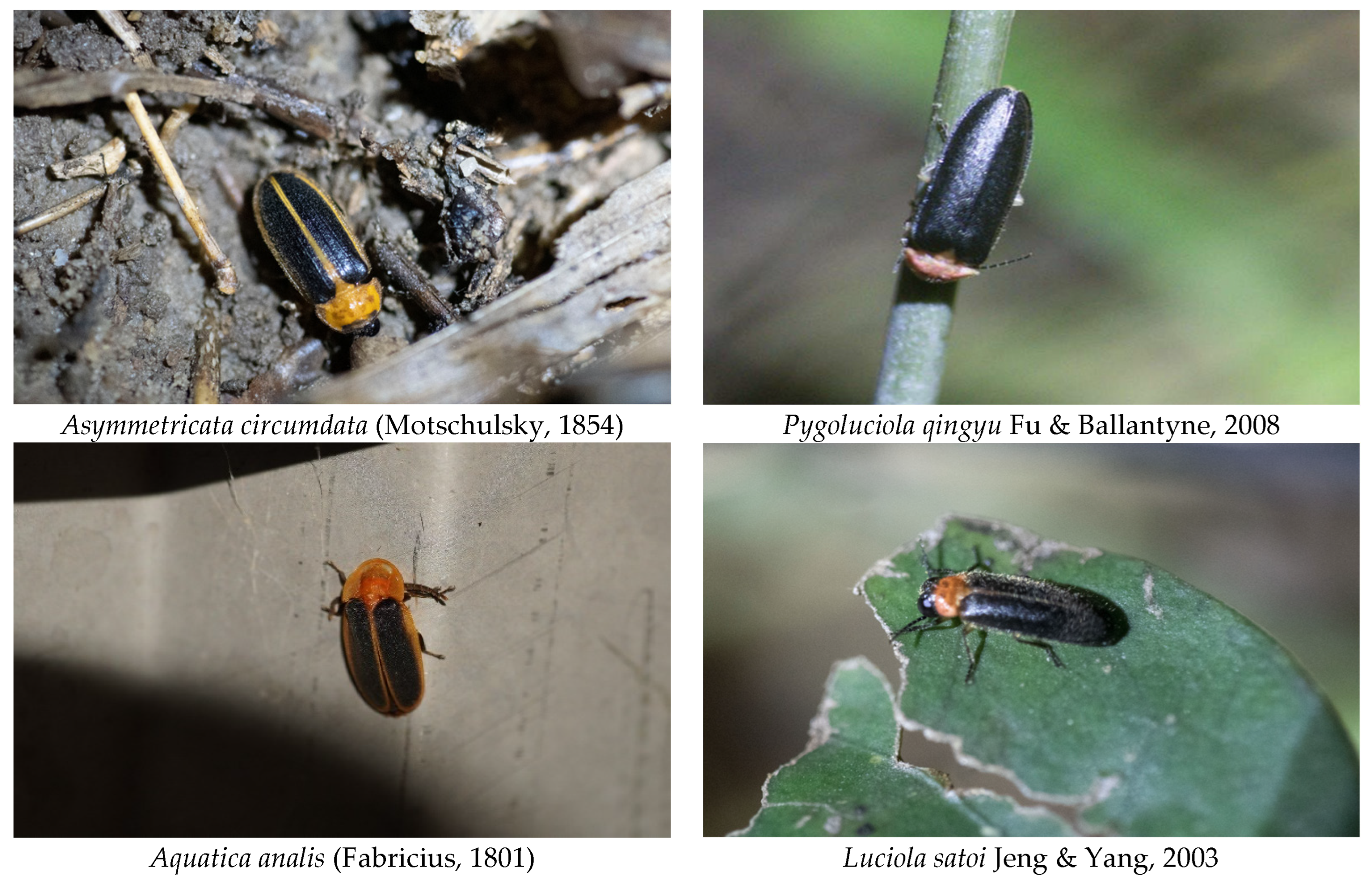
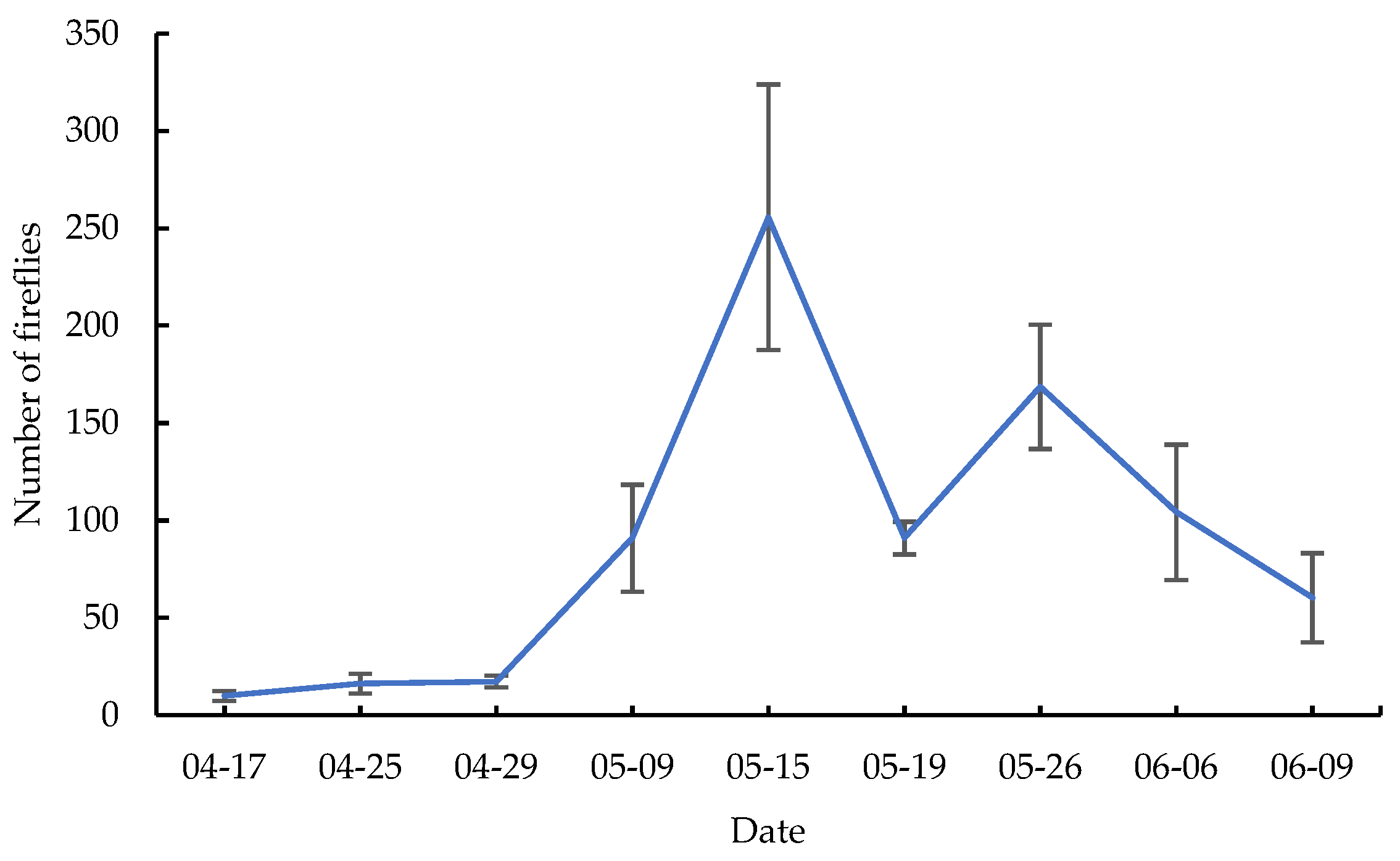

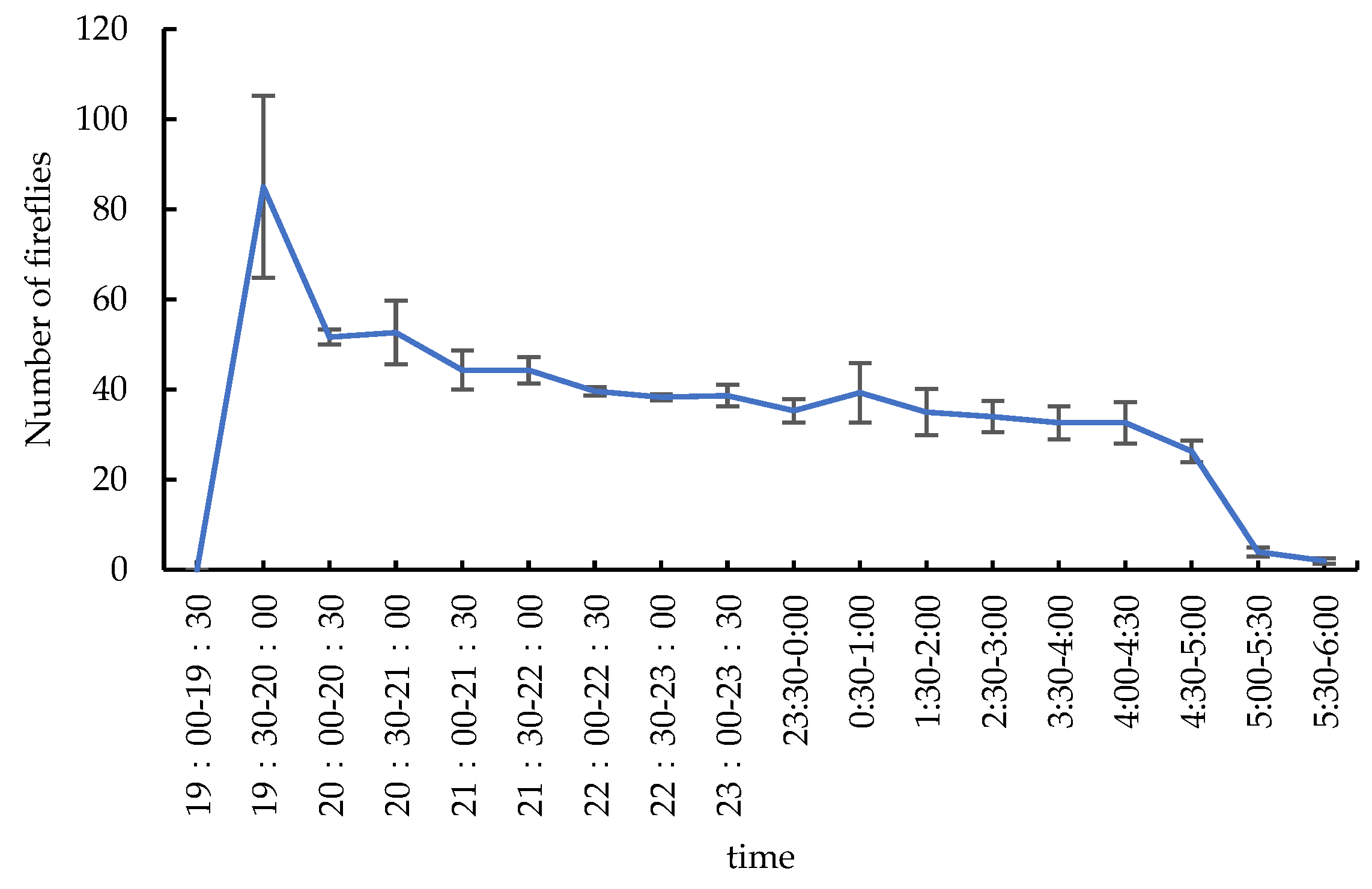
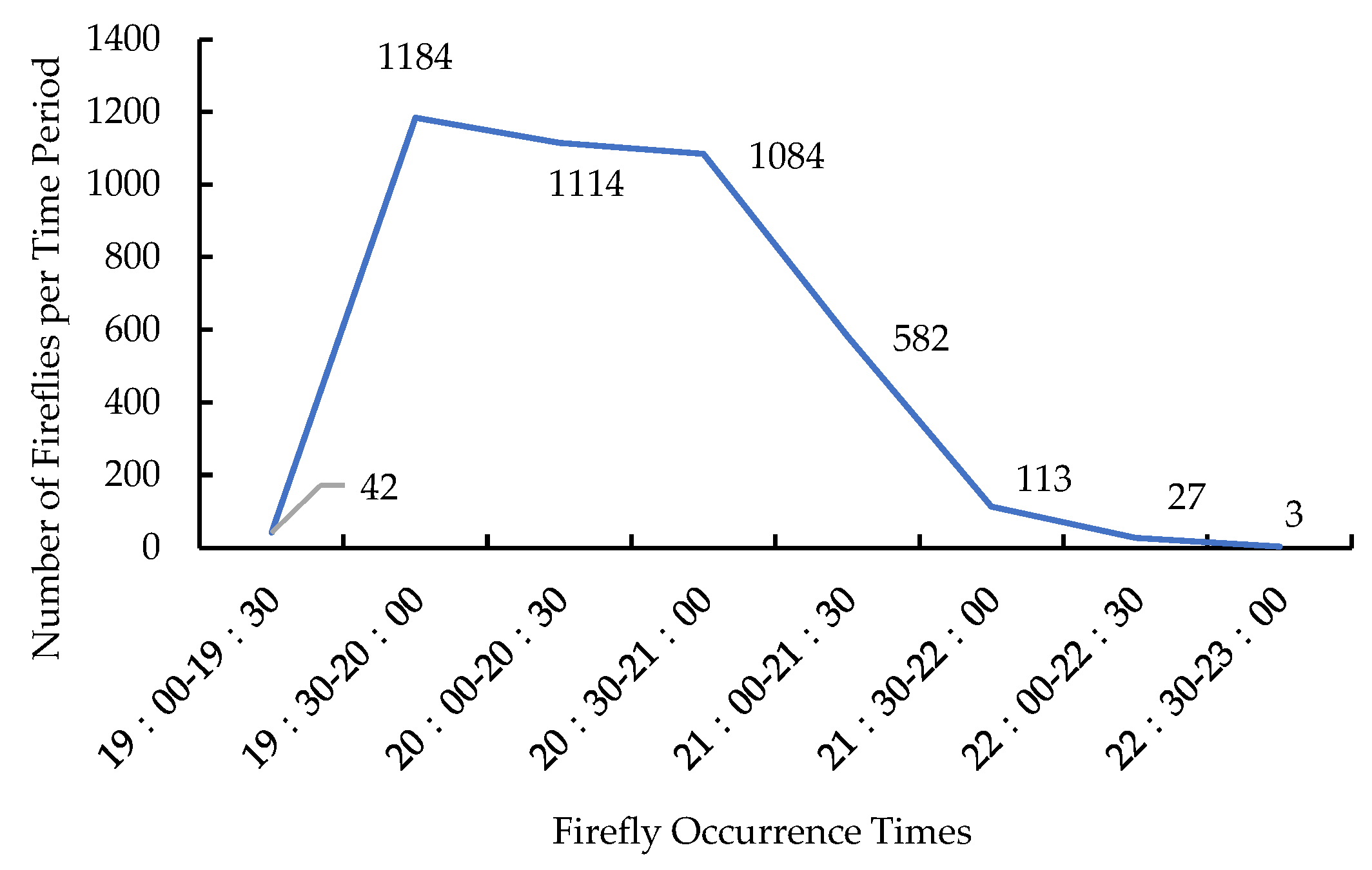
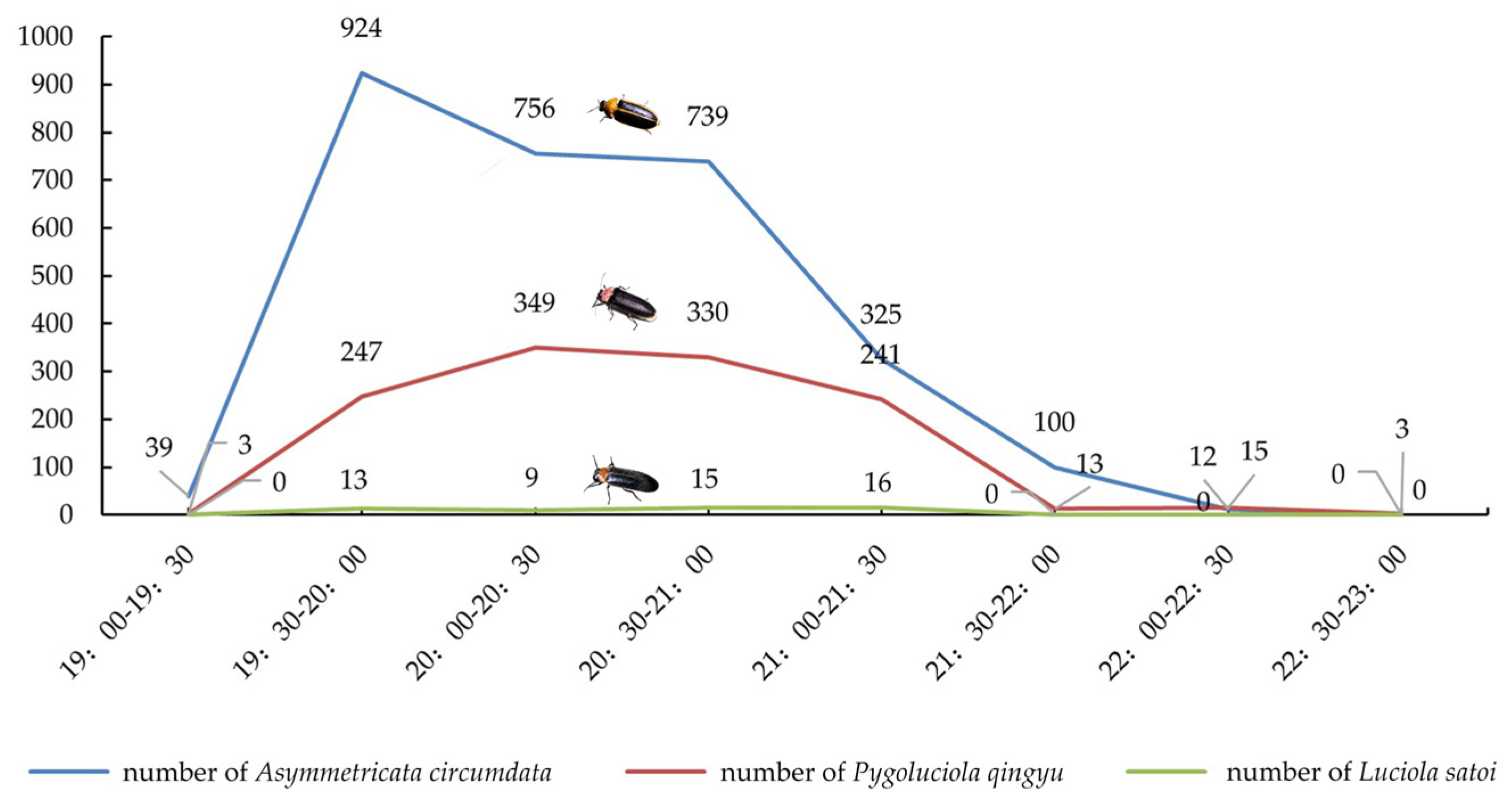
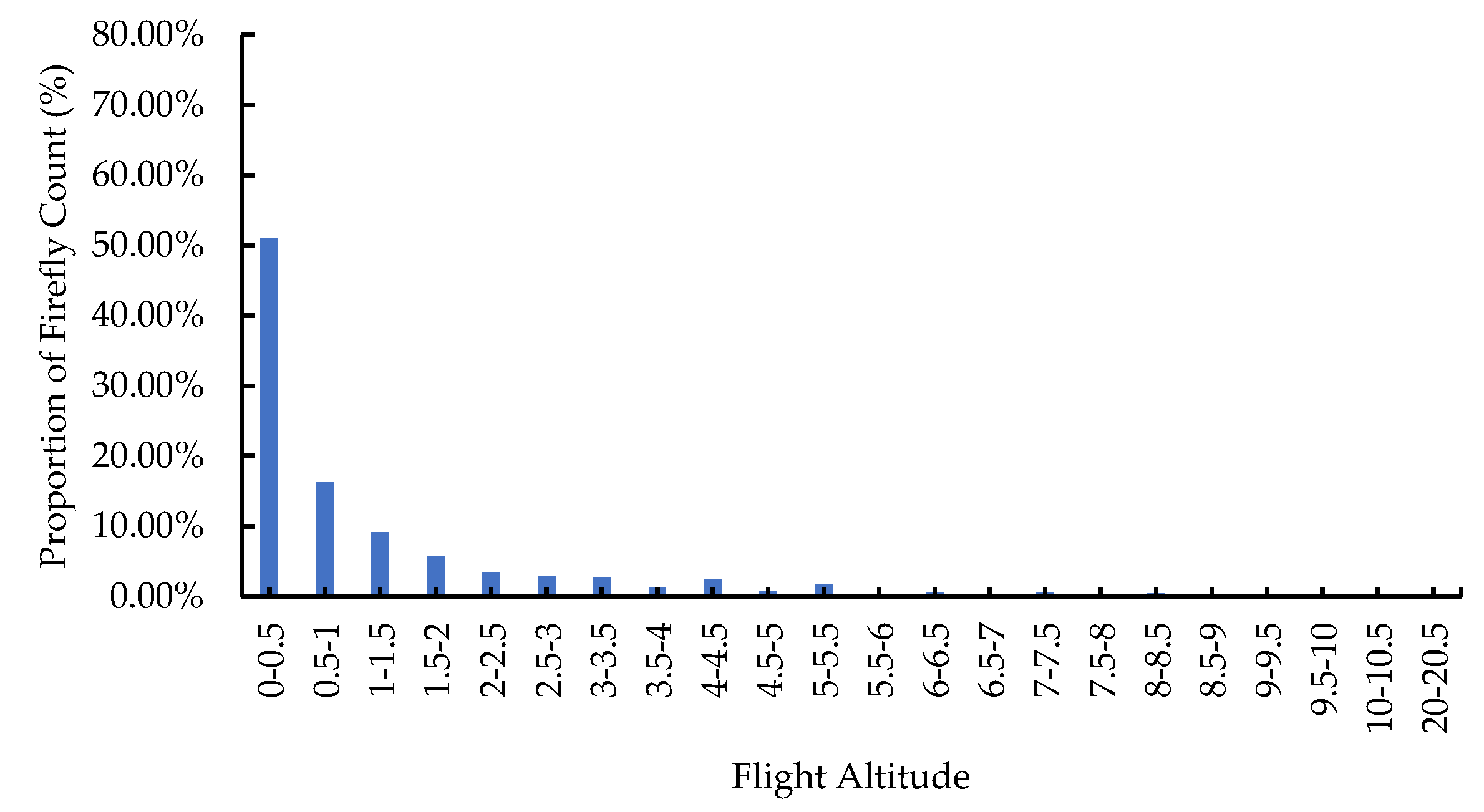
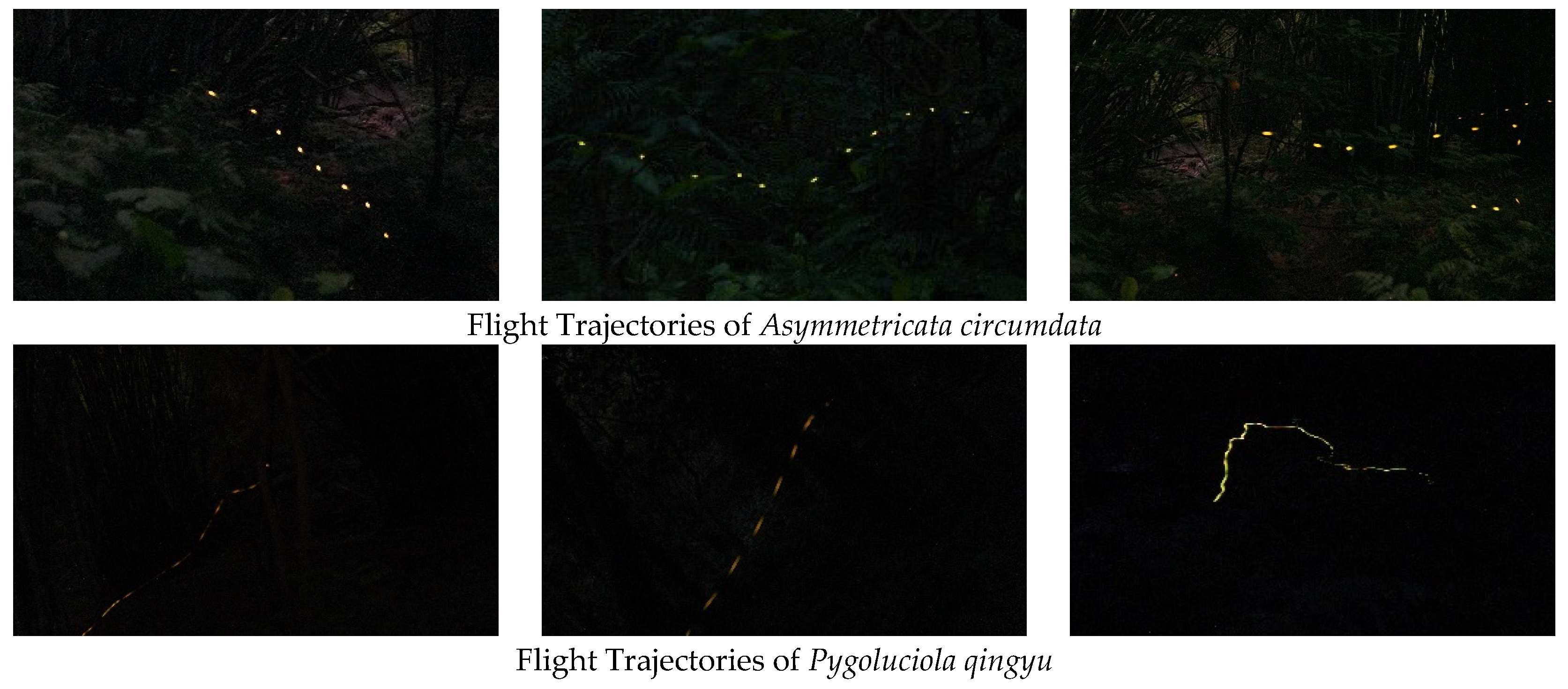

Disclaimer/Publisher’s Note: The statements, opinions and data contained in all publications are solely those of the individual author(s) and contributor(s) and not of MDPI and/or the editor(s). MDPI and/or the editor(s) disclaim responsibility for any injury to people or property resulting from any ideas, methods, instructions or products referred to in the content. |
© 2025 by the authors. Licensee MDPI, Basel, Switzerland. This article is an open access article distributed under the terms and conditions of the Creative Commons Attribution (CC BY) license (https://creativecommons.org/licenses/by/4.0/).
Share and Cite
Huang, Q.; Zeng, H.; Yan, C.; Liu, T.; Liu, S.; Sun, Z.; Zhang, C.; Chen, Z.; Peng, F.; Li, N.; et al. Firefly Species and Nocturnal Activity Patterns of Adults in Peri-Urban Forests of Dongguan. Forests 2025, 16, 1545. https://doi.org/10.3390/f16101545
Huang Q, Zeng H, Yan C, Liu T, Liu S, Sun Z, Zhang C, Chen Z, Peng F, Li N, et al. Firefly Species and Nocturnal Activity Patterns of Adults in Peri-Urban Forests of Dongguan. Forests. 2025; 16(10):1545. https://doi.org/10.3390/f16101545
Chicago/Turabian StyleHuang, Qingqing, Haicong Zeng, Chaodong Yan, Ting Liu, Songsong Liu, Zhenkai Sun, Chang Zhang, Zhenye Chen, Feng Peng, Niansheng Li, and et al. 2025. "Firefly Species and Nocturnal Activity Patterns of Adults in Peri-Urban Forests of Dongguan" Forests 16, no. 10: 1545. https://doi.org/10.3390/f16101545
APA StyleHuang, Q., Zeng, H., Yan, C., Liu, T., Liu, S., Sun, Z., Zhang, C., Chen, Z., Peng, F., Li, N., & Wang, C. (2025). Firefly Species and Nocturnal Activity Patterns of Adults in Peri-Urban Forests of Dongguan. Forests, 16(10), 1545. https://doi.org/10.3390/f16101545





